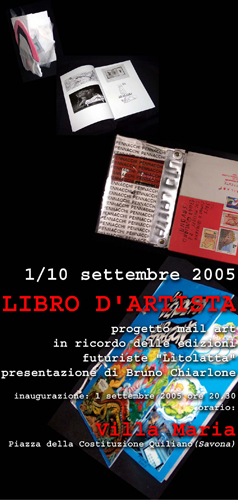|
|
 |
|---|---|
Images of the exhibition |
DOWNLOAD: Invitation.pdf - Poster.pdf |
IT |
EN |
|---|
|
|
 |
|---|---|
Images of the exhibition |
DOWNLOAD: Invitation.pdf - Poster.pdf |
The "artist's book" has been a cultural heritage of the historical "avant-gardes"' The futuristic movement, and lately the Dadaistic and Surrealistic ones, have made the book as an object become a sort of target for their own trasgressions, provocations, sídetrackings towards the traditional aura of the bookish culture and of the traditional obsolescence of the book as a simple object. But, with the aim of destroying the book, paradoxically, some artists made the pages of the books become indestructible: just in Savona books called "litolatta" were born from Marinetti and Tullio D'Albisola's imagination. Such particular books are composed of metallic pages - more precisely, they are
made of tin, just as their Italian name suggest ("latta") -. On these tin-plated pages, the artists printed words and sentences thus moulding figures and graphic pictures - all made with a lithographic procedure. Examples of this peculiar form of art are the collection "Parole in libertà futurisle olfattive tattiche termiche" and "L'anguria firica", famous work whose subheadíng is "lungo poema passionale", illustrated by Bruno Munari and printed by the "Litolatta" of Savona in 1934.
Thanks to these futuristic local works, the cultural Aldermanry of Quiliano, together with Bruno Cassaglia and Renato Cerisola's valid collaboration - the two artistic consultants of "SACS" (Spazio Arte Contemporanea Sperimentale) - has organized an exhibition titled "Líbri d'artista" ("artist's books") and invited the variegated microcosm of the "maif-artists" to send their own handmade books. Thus, a mail-art exhibition whose object is the artist's book.
For the "outsiders", the great majority of publíc, it is useful to point out that "the artist's book" is not a book on the history of art, neither it is an artístic monograph, nor an exhibition catalogue. Instead, as the Portuguese Fernando Aguiar says, "the artist's book is a work of art carried out with "the book" as the main concept". In response to the brilliant initiative, Quiliano received all sort of works. The maiI-artists from all over the World showed theír extraordinary creativity by sending their own works of art in
the shape of books which underlined their ability to respect and to re-invent the identity of an object which represents most of the history of mankind as a whole. The basic assumptions of the historical "avant-gardes", have changed: as well pointed out by my dear friend Gino Gini, "the artist works using less sharp tones, sometimes even very respectful, sometimes afraid of measure himseÌf with such an object rich in wisdom, culture, knowledge, religion...the artist use great technical capability, employing paper, gauzes, cloth and may other sophisticated materials - making of them all a poetic use, much more than just a polemic one. Thus, the rediscovery of a prècious and educated craftsmanship". In fact, despite the fast development of theinformation technologies - such as CDs, DVDs, video and virtual images which are transmissible through the internet, everywhere in the world- soon everyone realized how books are an irreplaceable heritage. A printed page of a book is still the ideal - support therefore transmitting ideas and images that can be easily kept for a long time on the shelves of the libraries ànd that can be always consufted without using particular technologies.
This very exhibition in Quiliano does contribute to celebrate the return of the book, re-created and re-invented from a different artist, every time. A painted page, or a drawn one, or even one created with a collage technique or several particular others are all added to others and collected in an object which is always up-to-date and that we can still appreciate as "artist's book".